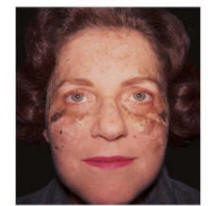Pemphigus Causes
Pemphigus Causes

Pemphigus is a autoimmune-related condition.
Autoimmune disorders are caused when the body's natural
defenses (e.g., antibodies) against "foreign" or
invading organisms begin to attack healthy tissue for
unknown reasons. Usually triggered by exposure to
chemicals , dyes, trauma, surgery and exposure to
infections. Carpet Shampoo is well known to trigger the
blistering in Kawasaki disease.
Benign Familial Pemphigus (Hailey-Hailey disease) is
inherited as an autosomal dominant trait. Human traits,
including the classic genetic diseases, are the product
of the interaction of two genes, one received from the
father and one from the mother. In dominant disorders, a
single copy of the disease gene (received from either
the mother or father) will be expressed "dominating" the
other normal gene and resulting in the appearance of the
disease. The risk of transmitting the disorder from
affected parent to offspring is 50 percent for each
pregnancy regardless of the sex of the resulting child.
More commonly seen in Jewish origin who intermarry
specially of Persian origin.
(
Pemphigus Foliaceus) is an autoimmune
blistering disorder that may be triggered by a substance
transmitted through the bite of blackflies.
Pemphigus may also occur following x-ray exposure or
adverse reaction to drugs such as d-penicillamine or
rifampin.
Affected Populations
Pemphigus
affects males and females in equal numbers and is most
common in middle-aged and elderly people. However, cases
of children with Pemphigus have been reported. This
disorder has been found in all ethnic groups and races,
but is more common in people of Jewish or Mediterranean
ancestry. Pemphigus occurs once in 100,000 people in the
United States.
Related Disorders
Symptoms of the following
disorders can be similar to those of
Pemphigus. Comparisons may be useful for a
differential diagnosis:
Bullous Pemphigoid is a chronic mild skin disorder that
generally affects elderly people. It is characterized by
large firm fluid-filled blisters (bullous pemphoid) that
heal quickly and typically disappear in several months
or years. However they may recur later. Early symptoms
include redness on the skin followed within weeks by the
appearance of blisters. The mucous membranes are rarely
affected by Bullous Pemphigoid. (For more information on
this disorder, see "Bullous
Pemphigoid"
Darier Disease (Darier-White Disease or Keratosis
Follicularis) is a progressive inherited skin disorder
characterized by widespread firm elevated lesions on the
skin and mucous membranes; abnormal changes of the
finger and toe nails may also occur. Symptoms usually
begin with a sensation of itching or burning on the
skin, especially the scalp, forehead, face, neck, and
back. Firm, elevated spots (papules) appear and
typically become large and darkened; eventually these
papules become scaly and crusty. As these spots enlarge,
they may come together and form larger areas. The
symptoms of Darier Disease tend to become more severe
during periods of emotional stress or with exposure to
sunlight. (For more information on this disorder, choose
"Darier" as your search term on the Rare Disease
Database.)
How to treat Pemphigus
1) Pemphigus is
simple use VITAMIN D 5000 units daily
